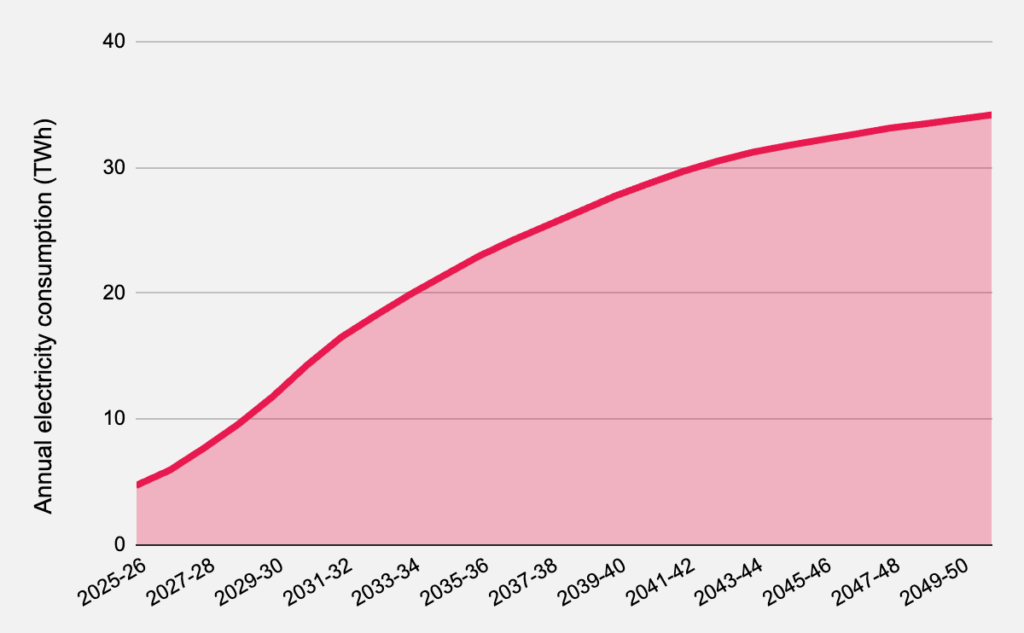Data centres make many of the things we take for granted in our day-to-day lives possible: sending emails, online shopping, streaming tv shows, cloud storage and navigation apps – the list goes on. They are the foundation of our growing digital economy, and are bringing new investment and skilled jobs to Australia. Data centres can help cut climate pollution and boost productivity by making many processes more efficient, but they also use large amounts of energy and water. As demand for data centres surges, driven largely by the growth in artificial intelligence (AI) and cloud computing, we need to carefully manage their impact on our grid and environment.
Here are eight key things to know about data centres and what they mean for Australia and our shift to renewables.
1. What are data centres?
Data centres are buildings that run all day, every day, to process, store, and manage digital data. They include equipment like servers, routers, switches, firewalls, and storage systems. They can range in size from small sites under 500 square metres, to massive “hyperscale” centres more than 100,000 square metres.
2. How many data centres are in Australia?
There are already more than 250 data centres in Australia. Despite our relatively small population, we are in the top five locations for data centres in the world. They’re usually near major cities, so they can be easily connected to the electricity grid and to the businesses and government agencies that rely on them.
3. How much energy does a data centre use?
Like their physical size, the energy needs of data centres vary greatly. Typical data centres are around 5-10 megawatts (MW) in size (NB 1 MW is enough to power around 300 homes). or use about as much energy as around 3000 houses. Emerging “hyperscale” data centres can be more than 100 MW, needing as much electricity as a small city. In total, Australia’s data centres currently use just over 2% of the power in our main grid, and this is expected to grow to around 6 per cent by 2030 as AI and cloud computing grow.
Data centre energy demand is forecast to grow nearly 5x over the next decade

4. How much climate pollution does a data centre create?
Most of the climate pollution from data centres comes from the electricity they use, and along their supply chains. The emissions from energy use depend on a centre’s size, location, and energy efficiency. For example, a data centre in a state with a high share of renewables like Tasmania, the ACT or South Australia, will generally have lower emissions than one in states that rely more on coal and gas. Some data centres are also cutting their climate pollution (and their power bills) by making or purchasing clean power.
What are the climate impacts of using AI?
AI is now powering processes and devices that many of us regularly use – like search engines, social media algorithms, maps apps, smart watches and voice recognition tools. It is becoming embedded in our digital lives, often without us playing an active role. More people and businesses are also actively using large language model (LLM) tools like ChatGPT. There are growing concerns about the climate and environmental impacts of AI.
Research estimates that a typical text-based AI query now uses about 0.2-0.3 watt-hours (Wh). The energy consumed depends on the model used, and increases with the complexity of the query – generating an image may use around 0.5Wh. For comparison, boiling a kettle uses around 100 Wh. The climate pollution from an AI query depends on many factors including the location of the data centre and measures it has in place to improve energy efficiency and use renewable power. Research shows that a typical AI query creates a few grams of carbon pollution.
Should I limit my AI use to reduce emissions?
Firstly, energy use and climate pollution are just two of many factors to consider when deciding whether to use AI tools. Minimising AI use is one thing we can do to reduce emissions, just like eating less meat, riding a bike to work instead of driving, or composting food waste. Ultimately though, governments and corporations have the responsibility to set and work within policy that addresses the climate emergency including by switching to renewable energy and away from fossil fuels.
5. How can data centres reduce their energy use and climate pollution?
There are many ways that data centres can cut climate pollution, and many are already being adopted in Australia. Many data centre operators in Australia have committed to 100% renewable energy by 2030. Actions they are taking include:
- Directly buying clean power through power purchase agreements (PPAs).
- Co-locating centres with renewable generation and big batteries, to reduce their energy costs and increase energy security while cutting climate pollution.
- Supporting the construction of large wind and solar farms to power data centre operations.
- Installing or upgrading equipment to improve energy efficiency.
Elsewhere around the world, data centres are:
- Shifting non-time sensitive tasks to times when large amounts of power are available, to help reduce strain on the grid.
- Using the heat they create to warm homes and businesses, much like many parts of the world already do with geothermal heat.
6. How can data centres help reduce climate pollution in other sectors?
AI and data centres have many existing and emerging applications that can help reduce emissions. For example, AI is already being used around the world to:
- detect leaks in oil and gas projects to cut pollution
- make manufacturing processes more efficient
- drive precision agriculture to reduce fertiliser, pesticide and water use while boosting productivity
- optimise energy use in buildings – for example, smarter heating and cooling can cut energy use by around 10 per cent.
Here in Australia, AI-integrated 3D concrete printing is being pioneered to help increase the environmental sustainability of the construction industry, and provide solutions for the housing crisis. The technology can cut construction waste by 60 per cent, production time by 70 per cent and labour costs by 80 per cent. In 2025, the first 3D-printed multi-storey house in the southern hemisphere was built in Melbourne in just five weeks.
7. What are the other environmental impacts of data centres?
Data centres generate a lot of heat and need huge amounts of water for cooling. A small one-megawatt data centre using traditional cooling methods can use around 26 million litres of water a year – enough for more than 150 average Australian homes. As southern Australia experiences one of its most severe droughts to date, water resources will become even more limited in some parts of the country in coming years under the changing climate. It’s critical that we manage the growth in data centres without placing extra strain on water supplies.
For example, we should ensure data centres are located in areas with sufficient water supply and infrastructure, and adopt systems that recover, treat and reuse water. New technologies are emerging too. In China, there is already one commercial-scale underwater data centre, and more are being built – using seawater for cooling rather than valuable freshwater. Roughly 40 percent of the electricity consumed by a typical data centre is for cooling – so innovative approaches like this are a win-win.
Data centres can also require significant amounts of land, can create noise pollution which impacts nearby communities and animals, and electronic waste that needs to be appropriately managed at its end of life.
8. How are we going to power the growing number of data centres?
As Australia electrifies homes, businesses, and vehicles, energy demand is rising. The rapid growth of data centres will place extra pressure on our grid. We have a timely opportunity to develop data centres in ways that support our shift to renewables – attracting investment in new clean power projects and cutting climate pollution across the economy.
Work is already underway: key energy bodies including the Australian Energy Market Operator (AEMO) and Australian Energy Market Commission (AEMC) are factoring data centre demand into future grid planning and market rules. The Australian Government is developing a new national data centre strategy, and already requires the data centres it uses to host government data to meet strong energy efficiency standards. Governments are major data centre customers, and these requirements set important expectations for the entire industry. Growing pressure from businesses, investors and the community to improve Environmental, Social and Governance (ESG) standards is reinforcing this trend. But further coordination and leadership is needed to ensure data centres are powered by renewables and reduce their impacts on the grid.
Data centres are essential for Australia’s growing digital economy, but the industry must grow in ways that align with our clean-energy future. With smart policy, industry leadership, and lessons from global best practice, Australia can harness the benefits of data centres while accelerating the shift to renewables.










